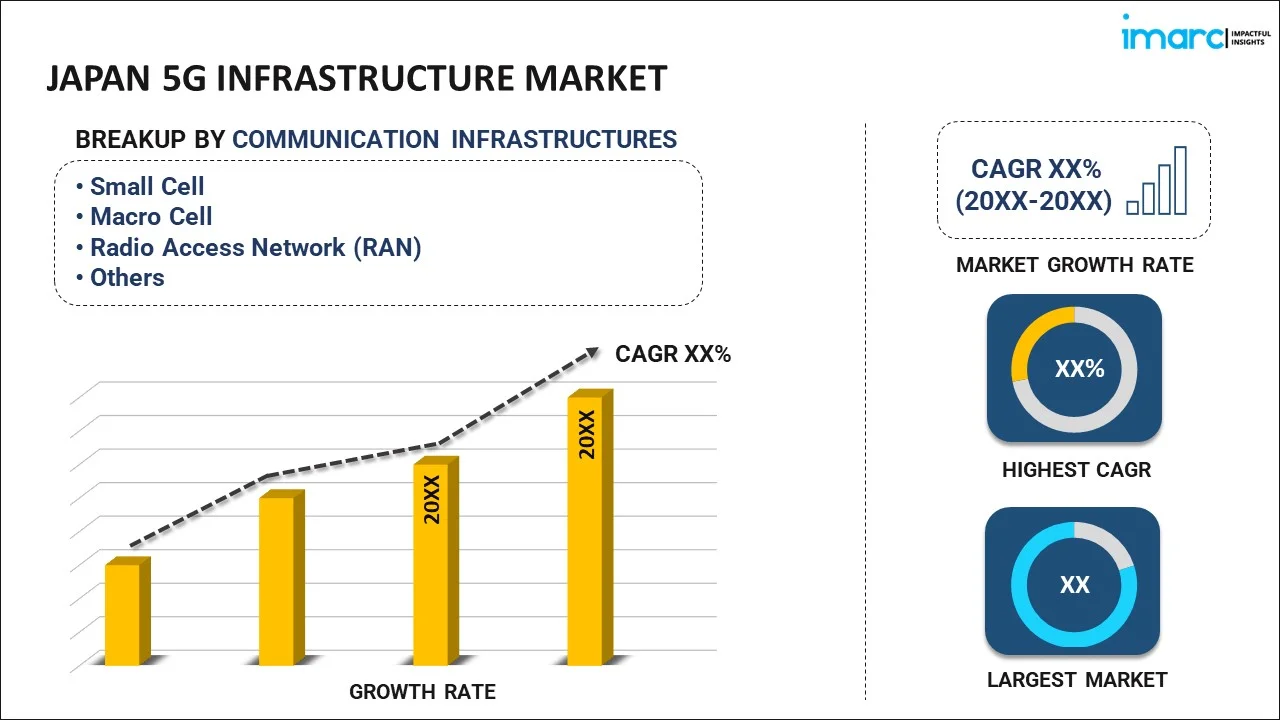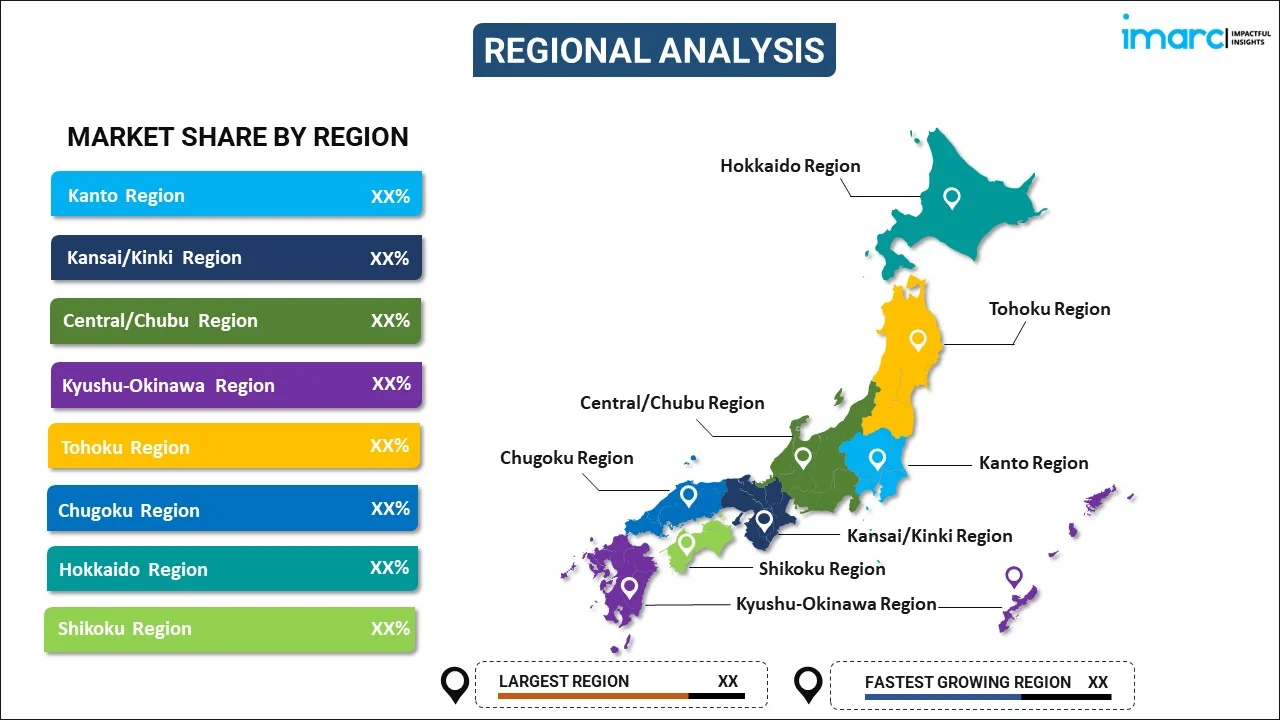
Japan 5G Infrastructure Market Report by Communication Infrastructure (Small Cell, Macro Cell, Radio Access Network (RAN), and Others), Network Technology (Software-Defined Networking, Network Function Virtualization, and Others), Network Architecture (Standalone, Non-Standalone), Frequency (Sub-6 Ghz, Above 6 Ghz), End User (Automotive, Energy and Utilities, Healthcare, Home User, and Others), and Region 2026-2034
Market Overview:
Japan 5G infrastructure market size reached USD 5.7 Billion in 2025. Looking forward, IMARC Group expects the market to reach USD 65.8 Billion by 2034, exhibiting a growth rate (CAGR) of 31.28% during 2026-2034. The escalating demand among people for high-speed and reliable internet connectivity, widespread adoption of remote work modules, and increasing investments by major tech and telecom companies in 5G infrastructure represent some of the key factors driving the market.
|
Report Attribute
|
Key Statistics
|
|---|---|
|
Base Year
|
2025
|
|
Forecast Years
|
2026-2034
|
|
Historical Years
|
2020-2025
|
|
Market Size in 2025
|
USD 5.7 Billion |
|
Market Forecast in 2034
|
USD 65.8 Billion |
| Market Growth Rate 2026-2034 | 31.28% |
Fifth-generation (5G) infrastructure refers to the network technology and physical hardware required to implement and operate the fifth generation of cellular network technology. It encompasses a range of new technologies and enhancements over 4G LTE, including advanced radio frequency (RF) technology, massive multiple input multiple output (MIMO), network slicing, and edge computing. It offers higher data speeds compared to 4G and allows for smoother streaming of high-definition (HD) video, faster downloads, and more efficient data transfer. It can create multiple virtual slices over a single physical network infrastructure, allowing for customization and optimization for different types of services and users. It is more energy-efficient as compared to its predecessors, reducing the carbon footprint associated with data transmission and processing. It supports emerging technologies like autonomous vehicles, smart cities, and advanced healthcare applications, providing the necessary speed and connectivity. It enables more efficient and flexible industrial automation, contributing to the advancement of Industry 4.0. Besides this, it enhances public safety and emergency services, providing better communication and response capabilities. It is widely used by factories and industrial setups for connecting a vast array of sensors and machines, enabling real-time monitoring and control. Moreover, as it can support a higher density of connected devices within a given area, the demand for 5G infrastructure is increasing in Japan.
Japan 5G Infrastructure Market Trends:
The escalating demand among people for high-speed and reliable internet connectivity represents one of the key factors facilitating the market growth in Japan. Additionally, the increasing popularity of online gaming, streaming services, and mobile internet usage in Japan is driving the demand for 5G infrastructure. Along with this, the widespread adoption of remote work modules in the country is catalyzing the demand for high-quality and fast internet. Apart from this, the growing focus on developing smart cities is driving the need for robust 5G infrastructure. The integration of the Internet of Things (IoT) devices in various aspects of urban living, ranging from traffic management to energy efficiency, requires high-speed, low-latency, and high-density connectivity is supporting the market growth in the country. Furthermore, the integration of 5G technology into the development of connected and autonomous vehicles is strengthening the growth of the market. Moreover, the increasing aging population in the country, coupled with the rising focus on healthcare, particularly telemedicine and remote health monitoring, are stimulating the market growth. 5G technology, with its high bandwidth and low latency, enables remote consultations, telehealth services, and real-time patient monitoring, thereby driving its adoption in the healthcare sector. In line with this, investments by major tech and telecom companies in 5G infrastructure are influencing the market positively in Japan.
Japan 5G Infrastructure Market Segmentation:
IMARC Group provides an analysis of the key trends in each segment of the market, along with forecasts at the country level for 2026-2034. Our report has categorized the market based on communication infrastructure, network technology, network architecture, frequency, and end user.
Communication Infrastructure Insights:

- Small Cell
- Macro Cell
- Radio Access Network (RAN)
- Others
The report has provided a detailed breakup and analysis of the market based on the communication infrastructure. This includes small cell, macro cell, radio access network (RAN), and others.
Network Technology Insights:
- Software-Defined Networking
- Network Function Virtualization
- Others
A detailed breakup and analysis of the market based on the network technology have also been provided in the report. This includes software-defined networking, network function virtualization, and others.
Network Architecture Insights:
- Standalone
- Non-Standalone
The report has provided a detailed breakup and analysis of the market based on the network architecture. This includes standalone and non-standalone.
Frequency Insights:
- Sub-6 Ghz
- Above 6 Ghz
A detailed breakup and analysis of the market based on the frequency have also been provided in the report. This includes sub-6 Ghz and above 6 Ghz.
End User Insights:
- Automotive
- Energy and Utilities
- Healthcare
- Home User
- Others
The report has provided a detailed breakup and analysis of the market based on the end user. This includes automotive, energy and utilities, healthcare, home user, and others.
Regional Insights:

- Kanto Region
- Kansai/Kinki Region
- Central/ Chubu Region
- Kyushu-Okinawa Region
- Tohoku Region
- Chugoku Region
- Hokkaido Region
- Shikoku Region
The report has also provided a comprehensive analysis of all the major regional markets, which include Kanto Region, Kansai/Kinki Region, Central/ Chubu Region, Kyushu-Okinawa Region, Tohoku Region, Chugoku Region, Hokkaido Region, and Shikoku Region.
Competitive Landscape:
The market research report has also provided a comprehensive analysis of the competitive landscape. Competitive analysis such as market structure, key player positioning, top winning strategies, competitive dashboard, and company evaluation quadrant has been covered in the report. Also, detailed profiles of all major companies have been provided.
Japan 5G Infrastructure Market Report Coverage:
| Report Features | Details |
|---|---|
| Base Year of the Analysis | 2025 |
| Historical Period | 2020-2025 |
| Forecast Period | 2026-2034 |
| Units | Billion USD |
| Scope of the Report | Exploration of Historical and Forecast Trends, Industry Catalysts and Challenges, Segment-Wise Historical and Predictive Market Assessment:
|
| Communication Infrastructures Covered | Small Cell, Macro Cell, Radio Access Network (RAN), Others |
| Network Technologies Covered | Software-Defined Networking, Network Function Virtualization, Others |
| Network Architectures Covered | Standalone, Non-Standalone |
| Frequencies Covered | Sub-6 Ghz, Above 6 Ghz |
| End Users Covered | Automotive, Energy and Utilities, Healthcare, Home User, Others |
| Regions Covered | Kanto Region, Kansai/Kinki Region, Central/ Chubu Region, Kyushu-Okinawa Region, Tohoku Region, Chugoku Region, Hokkaido Region, Shikoku Region |
| Customization Scope | 10% Free Customization |
| Post-Sale Analyst Support | 10-12 Weeks |
| Delivery Format | PDF and Excel through Email (We can also provide the editable version of the report in PPT/Word format on special request) |
Key Questions Answered in This Report:
- How has the Japan 5G infrastructure market performed so far and how will it perform in the coming years?
- What has been the impact of COVID-19 on the Japan 5G infrastructure market?
- What is the breakup of the Japan 5G infrastructure market on the basis of communication infrastructure?
- What is the breakup of the Japan 5G infrastructure market on the basis of network technology?
- What is the breakup of the Japan 5G infrastructure market on the basis of network architecture?
- What is the breakup of the Japan 5G infrastructure market on the basis of frequency?
- What is the breakup of the Japan 5G infrastructure market on the basis of end user?
- What are the various stages in the value chain of the Japan 5G infrastructure market?
- What are the key driving factors and challenges in the Japan 5G infrastructure?
- What is the structure of the Japan 5G infrastructure market and who are the key players?
- What is the degree of competition in the Japan 5G infrastructure market?
Key Benefits for Stakeholders:
- IMARC’s industry report offers a comprehensive quantitative analysis of various market segments, historical and current market trends, market forecasts, and dynamics of the Japan 5G infrastructure market from 2020-2034.
- The research report provides the latest information on the market drivers, challenges, and opportunities in the Japan 5G infrastructure market.
- Porter's five forces analysis assist stakeholders in assessing the impact of new entrants, competitive rivalry, supplier power, buyer power, and the threat of substitution. It helps stakeholders to analyze the level of competition within the Japan 5G infrastructure industry and its attractiveness.
- Competitive landscape allows stakeholders to understand their competitive environment and provides an insight into the current positions of key players in the market.
Need more help?
- Speak to our experienced analysts for insights on the current market scenarios.
- Include additional segments and countries to customize the report as per your requirement.
- Gain an unparalleled competitive advantage in your domain by understanding how to utilize the report and positively impacting your operations and revenue.
- For further assistance, please connect with our analysts.
 Request Customization
Request Customization
 Speak to an Analyst
Speak to an Analyst
 Request Brochure
Request Brochure
 Inquire Before Buying
Inquire Before Buying




.webp)




.webp)












